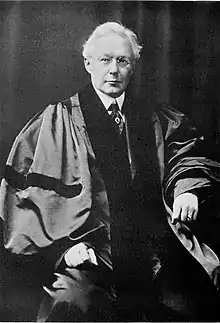William Churchill Hammond
William Churchill Hammond (November 25, 1860 – April 15, 1949)[1] was an American organist, choirmaster, and music educator at Mount Holyoke College, prolific in the first half of the 20th century as one of the founders of the American Guild of Organists.[2] One of the first two male faculty members hired by the college, Hammond would be influential in its establishment of a music major in 1935.[3][4] Extensively involved in the Second Congregational Church of Holyoke[lower-alpha 1] as its music director, his influence extended beyond his academic position. Among his pupils was John Shea, who would later write Notre Dame's Victory March, first playing it for his former teacher on the congregational church's organ in 1908.[5][6] Throughout his career Hammond himself would give more than 1,200 local recitals as well as organize and tour Mount Holyoke's Carol Choir to venues across the country, including the White House.[7][8] Hammond was also a collector of folklore songs, arranging and publishing Christmas carols through the New Haven Carol Society for more than 35 years, as well as most notably being the first musician to formally put the American folk-tune White's Air into print.[3]
William Churchill Hammond | |
|---|---|
 Hammond in academic regalia, c. 1916 | |
| Born | November 25, 1860 Rockville, Connecticut, U.S. |
| Died | April 15, 1949 (aged 88) Holyoke, Massachusetts |
| Occupation | Organist, choirmaster, educator |
| Years active | 1876–1949 |
| Spouse(s) | Fanny Bliss Reed (m. 1898) |
| Signature | |
Notes
- Today known as the United Congregational Church of Holyoke.
References
- "William Churchill Hammond". 2015: The Pioneer Valley, Western Massachusetts; The Organ Historical Society's 60th Annual Convention (PDF). Richmond, Va.: The Organ Historical Society. 2015. p. V-88. Archived from the original (PDF) on January 29, 2021.
- Owen, Barbara (February 1996). "American Guild of Organists Centennial: The Founders of the AGO- Who Were They?" (PDF). The American Organist. American Guild of Organists. p. 93. Archived from the original (PDF) on January 29, 2021.
- Jacobi, Bonnie Schaffhauser (October 2015). "'In Burst of Fresh Song': William Churchill Hammond and His Christmas Caroling Choir at Mount Holyoke College". Journal of Historical Research in Music Education. Sage Publications, Inc. XXXVII (1): 24–50.
- "Faculty and staff biographical files". Five College Consortium. Retrieved 2021-01-29.
The first male teachers, Asa Kinney (botany) and William Churchill Hammond (music), were hired in 1899.
- "People of Western New England – William C. Hammond". Western New England. Vol. III no. 4. Springfield, Mass.: Springfield Board of Trade. April 1913. p. 156.
- Wallace, Francis (1949). The Notre Dame Story. New York: Rinehart & Company, Inc. pp. 209–210.
- "He Had Something". The Catholic Digest. Vol. 7. College of St. Thomas. 1942.
They[, the Congregational church's deacons,] were not a little shocked to see a man wearing a Roman collar energetically thumping away on the keys of their organ. One deacon had a remark to make when the recital was finished. 'Brother,' he said, 'you've got something there'"
- "Notre Dame Victory March". Game Day. University of Notre Dame. Archived from the original on September 15, 2019.
- "He Had Something". The Catholic Digest. Vol. 7. College of St. Thomas. 1942.
- Clark, Rusty (2006). Stories Carved in Stone: Holyoke, Massachusetts. West Springfield, Mass.: Dog Pond Press. p. 163. ISBN 9780975536261.
- "William C. Hammond, Sixty Years at Post; Still Active in Holyoke" (PDF). The Diapason. XXXVI (4). Chicago: American Guild of Organists. March 1, 1945. p. 1. Archived from the original (PDF) on February 1, 2021.
Further reading
- Allyn, George H. (1912). Thirtieth Anniversary Sketch, Holyoke Daily Transcript, 1882–1912. The Transcript Publishing Co. p. 55. OCLC 24571746.
- Cutter, William Richard; Crane, Ellery Bicknell; Gardner, Eugene C.; Read, Charles French; Ballard, Harland Hoge; Rantoul, Robert Samuel; Lockwood, John H.; Dyer, E. Alden (1916). "Hammond, William Churchill". Encyclopedia of Massachusetts, Biographical–Genealogical. VI. Boston: The American Historical Society, Inc. pp. 87–92.
- Johnson, Clifton (ed.). "William Churchill Hammond, Mus. D.". Hampden County, 1636-1936 - Individual and Family Records. III. p. 68.
- "William Churchill Hammond". 2015: The Pioneer Valley, Western Massachusetts; The Organ Historical Society's 60th Annual Convention (PDF). Richmond, Va.: The Organ Historical Society. 2015. p. V-88. Archived from the original (PDF) on January 29, 2021.
- "William Churchill Hammond". The Story of Western Massachusetts. III. Lewis Historical Publishing Company, Inc. 1949. pp. 5–6 – via HathiTrust.
- "William Churchill Hammon, Mus. D; Organist, Choirmaster, Educator". Men of New England. New York: American Historical Company. 1941. pp. 207–209 – via Internet Archive.
External links
![]() Media related to William Churchill Hammond at Wikimedia Commons
Media related to William Churchill Hammond at Wikimedia Commons
- Hammond papers, Mount Holyoke College Archives and Special Collections